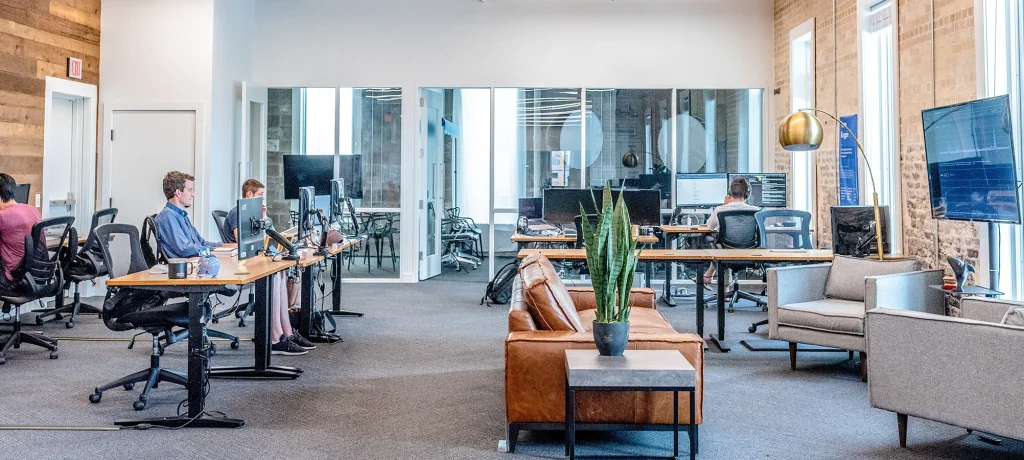
While the pandemic may not be entirely over, the worst seems to have passed thanks to the fast vaccination program. Many people spent months working from home and adapted their routines accordingly. Remote working is not a new idea; some businesses had been considering it for years. COVID expedited the rollout of it, almost like a mass experiment. Now, the question is being asked, what does the post-pandemic office look like?
Get a free demo
Enquire about a no-obligation demo today and get an exclusive hybrid working research paper — for free. Created in partnership with YouGov, this invaluable guide provides essential insights into developing your own effective hybrid strategy. Click below.
The digital age has left our infrastructures outdated in many ways. We have transitioned from an industrial age to an on-demand digital landscape. The technology to work from home has been ready for a few years. What COVID highlighted was the lacking infrastructure within companies to support new working models and employee wellness.
Traditionally the office was a place we attended 9-5 Monday-Friday to complete our work. We dressed appropriately, behaved accordingly, and built relationships with our colleagues. Having had a taste of working from home, many people want to continue having the option to at least part-time.
The Economist’s Future of Work report stated that the average employee would like to work from home nearly half the time. So, while most don’t want to work full-time from home, some would select the option. It makes sense for companies to offer home-working options to their employees as it could lead to downsizing of physical office space and overheads.
Some technology companies have understood the benefits of flexible working for many years. They were adopting a fun and flexible approach to working. The offices of companies such as Google have areas to rest, play, socialize, and more. Google were early pioneers of offices that keep their staff happy. Happy staff work harder and smarter.
How Can You Make Your Company’s Office Space 2.0 Ready?
Currently, many offices are set up traditionally, with a desk per employee, conference rooms, some have catering facilities, a breakroom and toilet facilities. In the future, if fewer people were in the office, the way it looks may change.
One of the biggest things people missed during the lockdown, working from home, was their colleagues. While collaboration took place online with meeting software such as Zoom or Teams, face-to-face meetings were canceled. For this reason, the majority would like to have some time in the office. Does every employee still need a desk, though?
Forward-thinking companies should consider the use of space if they intend to give employees the option to work flexibly in some hybrid working system. Collaboration is more successful in person; should the office focus more on collaborative environments?
The office is the place employees can immerse themselves in the workplace culture and socialize with colleagues to ensure a good standard of employee wellbeing and good mental health. Isolation and loneliness lead to depression and lower productivity.
With the above in mind, it’s essential to make your post-pandemic office an inviting, comfortable, and engaging place to be. Workplace wellbeing should be top of the agenda, with a focus on keeping staff happy. It, therefore, makes sense to ask for the opinions and ideas of the workforce to ensure your new way of working is successful and works for your team.
What Do You Need to Make the Post-Pandemic Office Work?
There will need to be collaboration across the different departments to make the post-pandemic office a success. It would be beneficial to make a checklist, to begin with, of all the systems, processes, equipment, and staff that need to be involved in developing the correct procedures.
Infrastructure
Robust IT infrastructure is the key to the success of new hybrid working models. If desk space is limited, then a desk reservation system will be necessary via hot desk booking software. Do staff need to book meeting rooms or collaboration space? If so, a meeting room booking system with meeting room management software should be in place.
For everything to work seamlessly, software system integration is vital. Having processes in place for staff to adhere to and integrated software applications to carry out their work wherever they are.
Processes
Updated HR policies will also be required. Will people be contracted to specific days in and out of the office, or will they decide themselves? Who will monitor the productivity and staff’s happiness? Agreements between organizations and staff will also need to be in place to ensure things like IT security procedures are always met.
Training will need to be given on new software, systems and ways of working. It’s all very well having things like room booking management software, but you need to ensure that staff are taught how to use it properly.
Expectations should also be laid out, including any KPIs that staff should be achieving, how they will be measured, and the processes for any staff falling behind. Productivity is understandably a big concern for employers. By setting out clear and defined goals, everyone knows where they stand.
Will there be any form of remuneration for staff that work from home to cover the cost of additional utility costs such as power, heat, and internet access? If so, guidelines will need to be drawn up along with contracts and processes for staff to either claim back costs or have an agreed sum added to their salary at a set rate.
Equipment
Does your equipment need upgrading for the post-pandemic office? This could be conference systems, cameras, screens, telephone systems, and even hardware. If desktop computers were the norm for upgrading, laptops might make more sense for their portability. Insurance should also be considered alongside data recovery systems.
Will employees be working from their own IT equipment from home? If so, what policies do you need to implement to ensure security and the safekeeping of sensitive data?
To ensure that employees are working securely and safely from home, a VPN service may help. This lets your company’s network know where the employee is accessing information, which can help prevent hacking attempts. Anti-virus software is a must to ensure no malware corrupts the system or steals data.
The employee will need to access the applications and programs that they use regularly; if they have a separate computer at work, they will need access remotely to their workspace. The cloud is ideal for this.
Could Offices Close Completely?
Some businesses may be considering eliminating their office spaces to cut their overheads dramatically. This will require a significant shake-up of all systems. Will staff work full-time from home, or will there be some form of third working space such as a collaborative hub where employees can get together to share ideas and work together?
British Airways are closing their Heathrow HQ as the large office complex will no longer be required with new working practices. They aren’t alone either. By downsizing and allowing staff to work from home, the company saves money. But the staff still need to be able to socialize to build bonds and working relationships that increase productivity and innovation.
Conference rooms or meeting rooms should still exist somewhere for staff to get together and collaborate. Management will also need to meet; HR will still need to speak to staff, hold reviews and interviews. If this space is in demand, then conference room booking systems will be imperative.
The success of a digital business depends on the systems and procedures underpinning it. These are what keep it running. The essential office infrastructure is the network, servers, and workstations. Equipment such as printers, copiers, etc., are all necessary.
We don’t imagine offices will completely close anytime soon, although they may be significantly downsized.
When COVID hit, we were all thrown unprepared into virtual meetings, virtual schooling, and isolation. Having no choice, the majority made it work, proving that working from home is a real possibility. The systems weren’t ready, but this real-world experiment has demonstrated what is needed to make it work.
IT executives now understand precisely how their teamwork from home, what they require access to, and what processes needed improvement. Larger companies such as Google will probably be early adopters, with smaller companies following suit in the next decade or so.
Imagine a workday in the year 2030 – you might not even need to go into an office. A service desk could deliver on-demand human resources, legal and accounting advice from anywhere with access to Wi-Fi. It may be standard practice for most workers to work on laptops or tablets at home and only come in for meetings. All of which will be booked online through booking software.
Ultimately the post-pandemic office will see many changes. While these may differ from company to company, it’s expected that more people will work flexibly across the globe. There are many benefits to this, with recruitment having a much wider pool of talent to choose from, happier staff and decreased overheads. The focus of offices may shift from work to a collaborative space to develop ideas, innovate and socialize immersed in the workplace culture.


